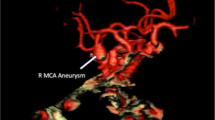Abstract
Clinical description
We report two cases of asymptomatic cerebral aneurysm in which cranial nerve palsy (CNP) developed shortly after symbolization. The CNP occurred immediately in case 1, but case 2 showed the CNP 30 h after symbolization. Although both aneurysms had increased in size on follow-up angiography, case 2 who showed dome re canalization resulted in progressive CNP deterioration.
Conclusion
These findings suggest that the CNP may result not only from mechanical compression by coils but also from inflammation induced by perpendicular thrombosis, and that the prognosis of the CNP may be influenced by dome re canalization. This complication should be kept in mind in treatment for asymptomatic aneurysms adjacent to the cranial nerves.


Similar content being viewed by others
References
Batjer HH, Purdy PD (1990) Enlarging thrombosed aneurysm of the distal basilar artery. Neurosurgery 26:695–700. doi:10.1097/00006123-199004000-00025
Birchall D, Khangure MS, McAuliffe W (1999) Resolution of third nerve paresis after endovascular management of aneurysms of the posterior communicating artery. AJNR Am J Neuroradiol 20:411–413
de Gast AN, Sprengers ME, van Rooji WJ, Lavini C, Sluzewski M, Majoie CB (2007) Midterm clinical and magnetic resonance follow-up of large and giant carotid artery aneurysms after therapeutic carotid artery occlusion. Neurosurgery 60:1025–1031. doi:10.1227/01.NEU.0000255468.30011.AA
Dixon DA, Tolley ND, Bemis-Standoli K, Martinez ML, Weyrich AS, Morrow JD, Prescott SM, Zimmerman GA (2006) Expression of COX-2 in platelet-monocyte interactions occurs via combinational regulation involving adhesion and cytokine signaling. J Clin Invest 116:2727–2738
Drake CG (1979) Giant intracranial aneurysms: experience with surgical treatment in 174 patients. Clin Neurosurg 26:12–95
Field M, Jungreis CA, Changelis N, Kromer H, Kirby L, Yonas H (2003) Symptomatic cavernous sinus aneurysm: management and outcome after carotid occlusion and selective revascularisation. AJNR Am J Neuroradiol 24:1200–1207
Gonzalez N, Murayama Y, Nien YL, Martin N, Frazee J, Duckwiler G, Jahan R, Gobin P, Viñuela F (2004) Treatment of unruptured aneurysms with GDCs: clinical experience with 247 aneurysms. AJNR Am J Neuroradiol 25:577–583
Gruber A, Killer M, Bavinzski G, Richling B (1999) Clinical and angiographic results of endosaccular coiling treatment of giant and very large intracranial aneurysms: a 7-year, single-centre experience. Neurosurgery 45:793–804. doi:10.1097/00006123-199910000-00013
Halbach VV, Higashida RT, Dowd CF, Barnwell SL, Fraser KW, Smith TP, Teitelbaum GP, Hieshima GB (1994) The efficacy of endosaccular aneurysm occlusion in alleviating neurological deficits produced by mass effect. J Neurosurg 80:659–666
Heran NS, Song JK, Kupersmith MJ, Niimi Y, Namba K, Langer DJ, Berenstein A (2007) Large ophthalmic segment aneurysms with anterior pathway compression: assessment of anatomical and visual outcome after endosaccular coil therapy. J Neurosurg 106:968–975. doi:10.3171/jns.2007.106.6.968
Horie N, Kitagawa N, Morikawa M, Tsutsumi K, Kaminogo M, Nagata I (2007) Progressive peri-aneurysmal oedema induced after endovascular coil embolisation. Report of three cases and review of the literature. J Neurosurg 106:916–920. doi:10.3171/jns.2007.106.5.916
Johnson SC, Zhao S, Dudley RA, Berman MF, Gress DR (2001) Treatment of unruptured cerebral aneurysms in California. Stroke 32:597–605
Kai Y, Hamada J, Morioka M, Yano S, Mizuno T, Kuroda J, Todaka T, Takeshima H, Kuratsu J (2007) Treatment strategy for giant aneurysm in the cavernous portion of the internal carotid artery. Surg Neurol 67:148–155. doi:10.1016/j.surneu.2006.03.037
Kazekawa K, Tsutsumi M, Aikawa H, Iko M, Kodama T, Go Y, Tanaka A (2003) Internal carotid artery aneurysm presenting with mass effect symptoms of cranial nerve dysfunction: efficacy and limitations of endosaccular embolisation with GDC. Radiat Med 21:80–85
Levi M, van der Poll T (2005) Two-way interactions between inflammation and coagulation. Trends Cardiovasc Med 15:254–259. doi:10.1016/j.tcm.2005.07.004
Litofsky NS, Viñuela F, Gianotta SL (1994) Progressive visual loss after electrothrombosis treatment of a giant intracranial aneurysm: case report. Neurosurgery 34:548–551
Malisch TW, Guglielmi G, Viñuela F, Duckwiler G, Gobin YP, Martin NA, Frazee JG, Chmiel JS (1998) Unruptured aneurysms presenting with mass effect symptoms: response to endosaccular treatment with Guglielmi detachable coils. Part I. Symptoms of cranial nerve dysfunction. J Neurosurg 89:956–961
Mavilio N, Pisani R, Rivano C, Testa V, Spaziante R, Rosa M (2000) Recovery of third nerve palsy after endovascular packing of internal carotid-posterior communicating artery aneurysms. Intervent Neuroradiol 6:203–209
Oglivy CS, Hoh BL, Singer RJ, Putman CM (2002) Clinical and radiographic outcome in the management of posterior circulation aneurysms by use of direct surgical or endovascular technique. Neurosurgery 51:14–22. doi:10.1097/00006123-200207000-00003
Pickett GE, Laitt RD, Herwadkar A, Hughes DG (2007) Visual pathway compromise after hydrocoil treatment of large ophthalmic aneurysms. Neurosurgery 61:E873–E874
Raaymakers TW, Rinkel GJ, Limberg M, Algra A (1998) Mortality and morbidity of surgery for unruptured intracranial aneurysms: a meta-analysis. Stroke 29:1531–1538
Rodríguez-Catarino M, Frisén L, Wikholm G, Elfverson J, Quiding L, Svendsen P (2002) Internal carotid artery aneurysms, cranial nerve dysfunction and headache: the role of deformation and pulsation. Neuroradiology 45:236–240
Russell SM, Nelson PK, Jafer JJ (2002) Neurological deterioration after coil embolisation of a giant basilar apex aneurysm with resolution following parent artery clip ligation. Case report and review of the literature. J Neurosurg 97:705–708
Schmidt GW, Oster SF, Golnik KC, Tumialán LM, Biousse V, Turbin R, Prestigiacomo CJ, Miller NR (2007) Isolated progressive visual loss after coiling of paraclinoid aneurysm. AJNR Am J Neuroradiol 28:1882–1889. doi:10.3174/ajnr.A0690
Stracke CP, Krings T, Möller-Hartman W, Mahdavi A, Klug N (2007) Severe inflammatory reaction of the optic system after endovascular treatment of a supraophthalmic aneurysm with bioactive coil. AJNR Am J Neuroradiol 28:1401–1402. doi:10.3174/ajnr.A0550
Strother CM, Eldevik P, Kikuchi Y, Graves V, Partington C, Merlis A (1989) Thrombus formation and structure and the evolution of mass effect in intracranial aneurysms treated by balloon embolisation: emphasis on MR findings. AJNR Am J Neuroradiol 10:787–796
Author information
Authors and Affiliations
Corresponding author
Rights and permissions
About this article
Cite this article
Nishino, K., Ito, Y., Hasegawa, H. et al. Development of cranial nerve palsy shortly after endosaccular embolization for asymptomatic cerebral aneurysm: report of two cases and literature review. Acta Neurochir 151, 379–383 (2009). https://doi.org/10.1007/s00701-009-0234-4
Received:
Accepted:
Published:
Issue Date:
DOI: https://doi.org/10.1007/s00701-009-0234-4




